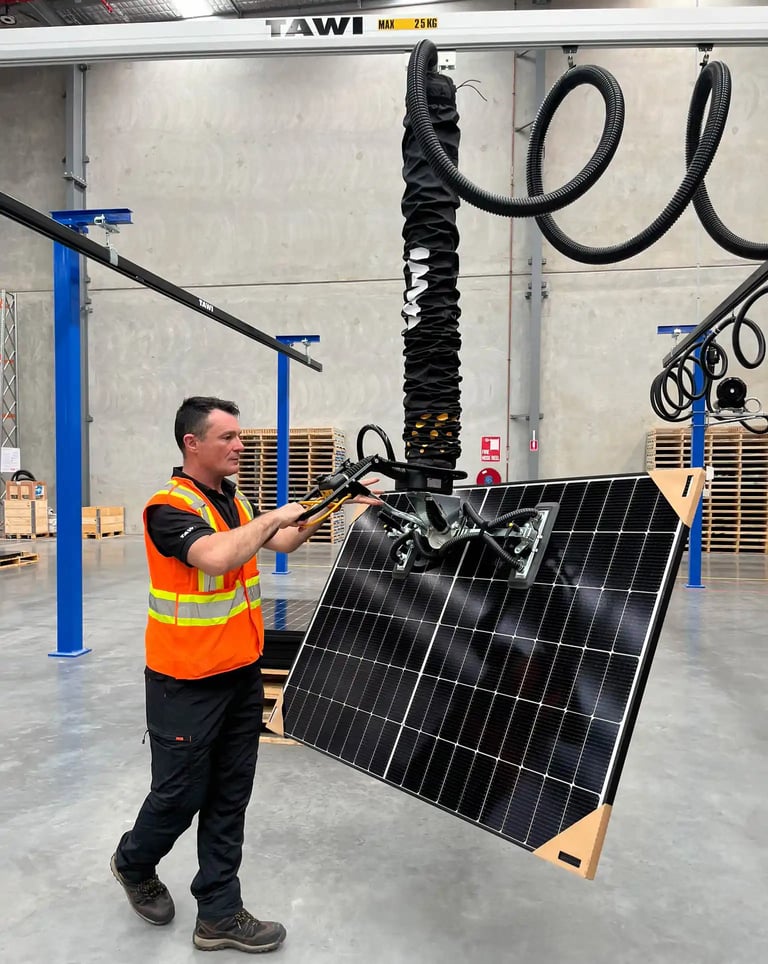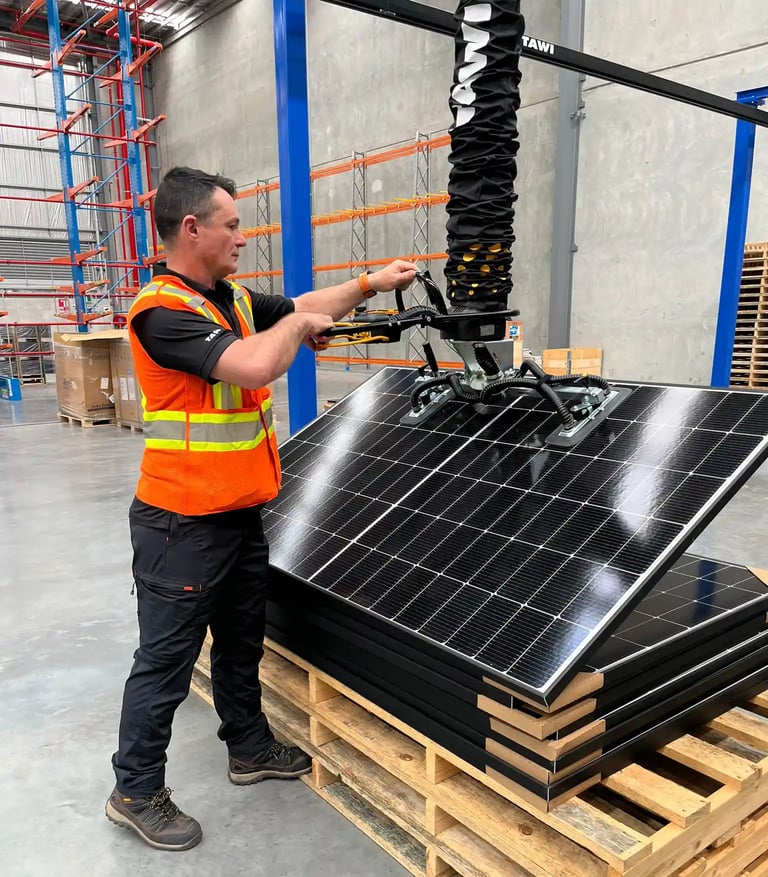Equipamento de Elevação para Painéis Solares em um Setor em Crescimento

A indústria solar está se expandindo mais rápido do que nunca. À medida que os volumes de produção aumentam, um desafio cresce na mesma proporção: o manuseio seguro e eficiente de materiais.
Como Superar os Desafios de Manuseio de Materiais na Fabricação e Inspeção Solar
A indústria solar está se expandindo mais rápido do que nunca. À medida que os volumes de produção aumentam, um desafio cresce na mesma proporção: o manuseio seguro e eficiente de materiais.
Manusear painéis solares pode parecer simples, mas cada elevação, rotação e movimento envolve riscos. Os painéis são frágeis, caros e facilmente danificados. A elevação manual expõe os operadores a lesões por esforço, enquanto fluxos de trabalho ineficientes podem desacelerar a produção e aumentar os custos.
É aqui que os equipamentos ergonômicos de elevação para painéis solares fazem toda a diferença, protegendo tanto as pessoas quanto os produtos ao longo da cadeia de valor.
Os Desafios Ocultos do Manuseio de Materiais de Painéis Solares
- Produção e Montagem
Nas linhas de fabricação, os painéis solares precisam ser movidos entre as estações de montagem, laminação e estruturação. O manuseio manual pode causar microfissuras, desalinhamento ou danos superficiais. À medida que o tamanho dos painéis aumenta, também cresce o risco de esforço ergonômico para os trabalhadores que realizam elevações repetitivas. - Inspeção e Controle de Qualidade
Durante a inspeção, os painéis frequentemente são inclinados ou girados para checagem de ambos os lados. Sem o equipamento adequado, esse processo pode ser inconsistente e fisicamente exigente. Mesmo um pequeno arranhão ou dobra pode resultar na rejeição do produto e perda de tempo. - Embalagem e Expedição
Embalagens seguras exigem precisão e cuidado. Um deslize durante o empilhamento ou carregamento pode quebrar o vidro ou danificar as molduras. Os painéis normalmente pesam de 30 a 50 kg ou mais, tornando a elevação manual insegura e ineficiente. - Distribuição e Armazenamento
Os painéis solares são propensos a danos durante o armazenamento e o manuseio inadequado representa riscos. No armazenamento em armazéns, os painéis devem ser descarregados, transportados e posicionados com cuidado. O manuseio improvisado ou a elevação por duas pessoas aumentam o risco de lesões e danos ao produto.
Por Que o Manuseio Manual Não É Sustentável
Os custos do manuseio inadequado de painéis solares vão além dos riscos de segurança:
- Perda de produto: Mesmo danos menores podem comprometer o desempenho e a garantia.
- Lesões de trabalhadores: Elevações repetitivas ou desconfortáveis levam à fadiga e distúrbios musculoesqueléticos.
- Ineficiência: O manuseio manual desacelera a produção e causa gargalos no fluxo de trabalho.
- Custos mais altos: Mais mão de obra e tempo de inatividade aumentam as despesas operacionais.
À medida que a fabricação solar se expande globalmente, métodos confiáveis e ergonômicos de elevação tornam-se essenciais para a eficiência e qualidade.
Maneiras Mais Inteligentes e Seguras de Elevar Painéis Solares
Equipamentos modernos de elevação para painéis solares utilizam tecnologia de vácuo e design ergonômico para tornar o manuseio rápido, preciso e sem esforço.
Manipuladores a Vácuo para Painéis Solares
Manipuladores a Vácuo usam sucção poderosa para segurar os painéis com segurança, sem pinças ou pressão sobre superfícies delicadas. Os operadores podem levantar, inclinar e girar os painéis com precisão, tudo com uma alça ergonômica. Isso reduz o tempo de manuseio e minimiza o risco de arranhões ou quebras.
Um sistema de elevação para painéis solares permite que um único operador mova painéis pesados ou grandes com segurança. Essas soluções são ideais para ambientes de montagem, inspeção e embalagem, onde flexibilidade e velocidade são essenciais.
Estações de Trabalho Ergonômicas
Integrar soluções de elevação diretamente nas estações de produção ou inspeção garante que os painéis sejam sempre manuseados na altura e ângulo corretos, mantendo um fluxo de trabalho consistente e reduzindo o esforço físico dos operadores.
Suporte para Armazém e Instalação
Na logística, dispositivos móveis de elevação e sistemas assistidos por vácuo facilitam a elevação, movimentação e posicionamento seguro dos painéis — mesmo em áreas de armazenamento compactas.

Eficiência Real na Produção Solar
Um grande fabricante solar enfrentava desafios recorrentes em sua linha de inspeção: elevações manuais frequentes, verificações de qualidade inconsistentes e fadiga crescente dos trabalhadores. Ao integrar equipamentos de elevação TAWI com tecnologia de vácuo, a empresa permitiu que operadores levantassem e inclinassem grandes painéis com mínimo esforço.
O resultado? Redução no tempo de ciclo por painel, menos unidades danificadas e melhores índices de segurança dos funcionários. O processo de manuseio tornou-se mais suave, permitindo que um único operador gerenciasse o que antes exigia duas pessoas.
Esse exemplo ilustra como a elevação ergonômica não se trata apenas de segurança — é uma ferramenta de produtividade que cresce junto com o setor. À medida que os painéis aumentam de tamanho e a demanda acelera, o manuseio eficiente garante que os fabricantes possam atingir metas de produção sem comprometer a qualidade ou o bem-estar dos funcionários.
Investindo em Manuseio Sustentável
A sustentabilidade não termina com a energia que um painel solar produz — ela começa com a forma como ele é fabricado. Equipamentos inteligentes de elevação apoiam a fabricação sustentável ao reduzir desperdícios, consumo de energia e lesões no ambiente de trabalho.
Ao minimizar danos ao produto durante o manuseio, as empresas reduzem o descarte e garantem que mais painéis cheguem ao mercado intactos, contribuindo diretamente para a eficiência de recursos. Ao mesmo tempo, sistemas ergonômicos de elevação reduzem o impacto físico nos funcionários, promovendo uma força de trabalho mais saudável e sustentável.
Com o tempo, essas melhorias se traduzem em economias mensuráveis: menos tempo de inatividade, menos painéis danificados e fluxos de trabalho mais seguros significam custos operacionais totais mais baixos e maior produtividade. Para muitos fabricantes, o retorno sobre o investimento em sistemas de manuseio de painéis solares vem não apenas dos ganhos de eficiência, mas também da redução de riscos e melhoria do bem-estar dos funcionários
O Futuro do Manuseio de Painéis Solares
A tecnologia solar deve representar 80% do crescimento da capacidade renovável global entre 2024 e 2030. À medida que a produção solar se torna cada vez mais automatizada, os equipamentos de elevação também evoluem. A integração de elevadores inteligentes e sistemas a vácuo com linhas de produção automatizadas permite transferências contínuas entre operadores humanos e robôs — garantindo fluxo contínuo sem intervenção manual.
Benefícios das Soluções de Elevação Inteligentes
A mudança do manuseio manual para o assistido de painéis solares traz resultados mensuráveis:
- Menor esforço físico para os operadores
- Menos painéis danificados durante o manuseio
- Maior velocidade e fluxos de trabalho mais suaves
- ]Mais segurança e satisfação dos funcionários
Sistemas ergonômicos de elevação não só aumentam a eficiência, mas também promovem um ambiente de trabalho mais seguro e sustentável, alinhando-se perfeitamente à missão da indústria solar de criar soluções energéticas mais limpas e inteligentes.
Elevação e Manuseio Inteligente com a TAWI
Na TAWI, ajudamos fabricantes solares a manusear painéis com segurança e eficiência, com equipamentos inovadores projetados para precisão e facilidade de uso. Cada elevador de painel solar TAWI é construído para proteger seus produtos, sua equipe e sua produtividade.
Pronto para tornar seu processo de manuseio solar mais seguro e eficiente? Descubra como os sistemas de elevação TAWI podem otimizar seu fluxo de trabalho com painéis solares.